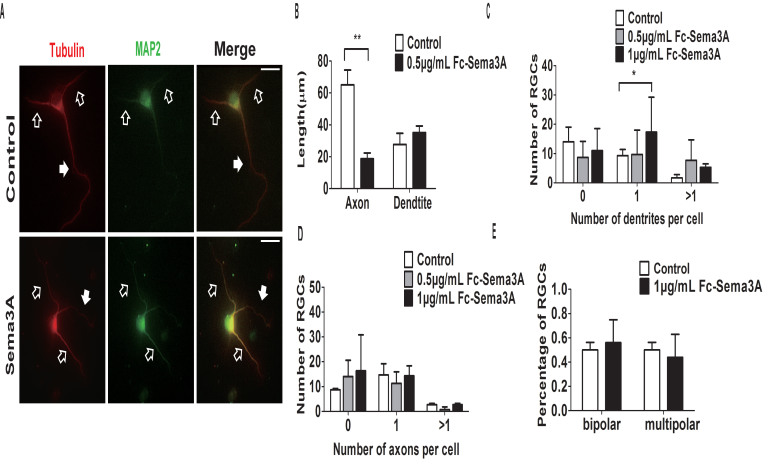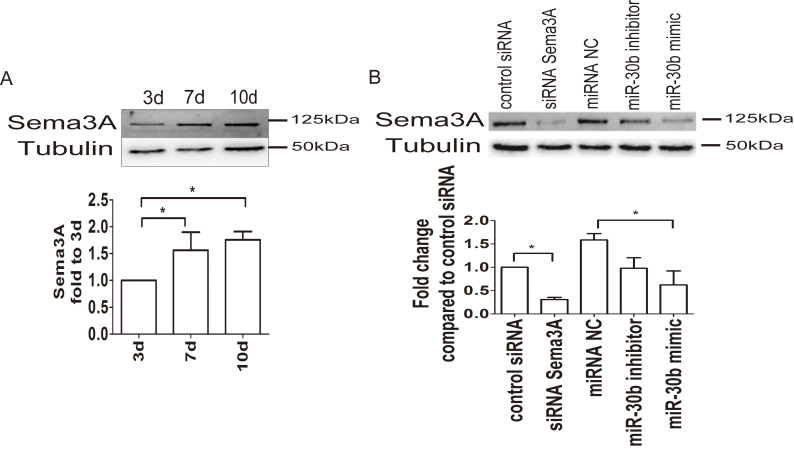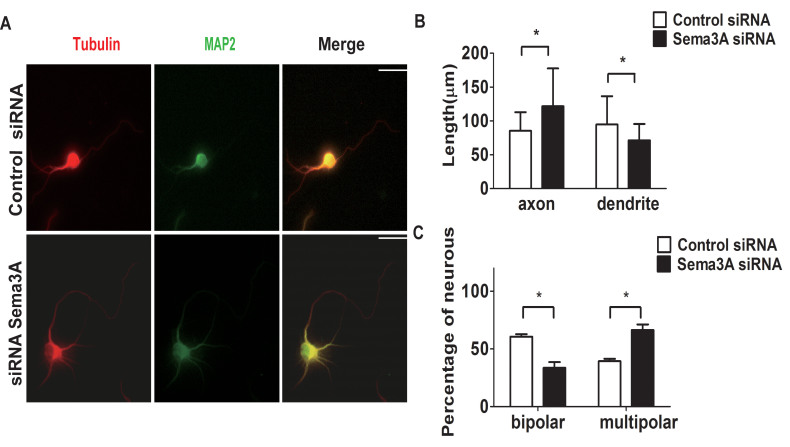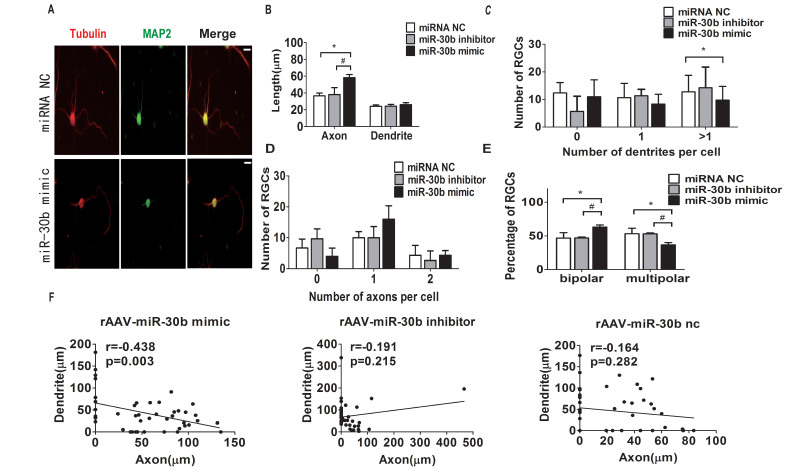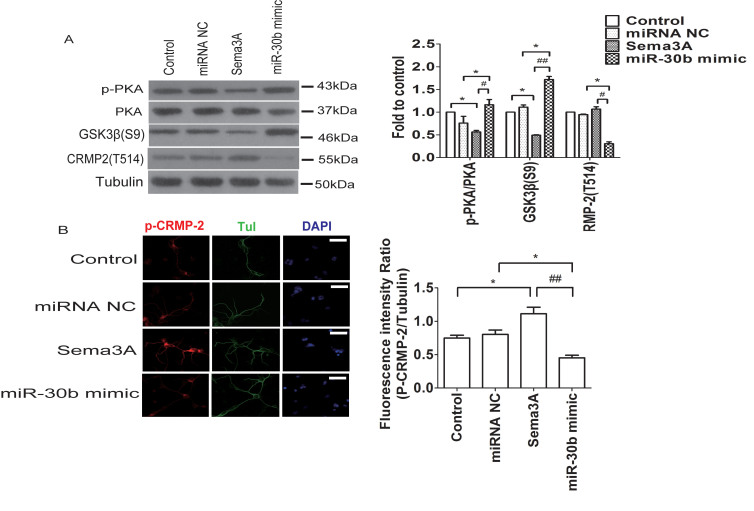Abstract
Purpose
Retinal ganglion cell (RGC) polarity plays an important role in optic nerve regeneration. This study was designed to investigate whether semaphorin-3A (Sema3A) is involved in the regulation of RGC polarity and Sema3A protein expression.
Methods
Cultured primary RGCs were treated with Fc-Sema3A or Sema3A siRNA or transfected with purified miR-30b recombinant adenoassociated virus (rAAV). The polarity of the RGCs was observed with immunofluorescence. A western blot analysis of phosphorylated protein kinase A (p-PKA), the downstream effector molecule phosphorylated glycogen synthase kinase 3 beta (GSK-3β), and collapsing response mediator protein 2 (CRMP2) was performed.
Results
We found that Sema3A could statistically significantly promote dendritic branching while inhibiting the growth of axons in RGCs. miR-30b overexpression and Sema3A siRNA could statistically significantly promote the growth of axons while inhibiting the growth of dendrites from RGCs. Additionally, miR-30b could restrain the expression of Sema3A protein and its downstream PKA/GSK-3β/CRMP2 signaling pathways.
Conclusions
The results indicate that Sema3A promotes dendritic growth and inhibits axonal growth, which is not conducive to the early repair of optic nerve injury. The overexpression of miR-30b can overcome this problem, and may represent a new target for the treatment of nerve injury and regeneration in the future.
Introduction
Neuronal polarity is the process in which a neurite rapidly grows into an axon, and the remaining neurites differentiate into dendrites [1]. Understanding the mechanisms that govern cell polarity may be critical for developing strategies for treating KLF5b deletion that induces locomotor impairments [2], and accelerate retinal ganglion cell (RGC) axon regeneration [3,4] and prevent neurodegeneration, such as Alzheimer disease [5,6]. Retinal ganglion cells are the inner neurons of the retina, and can transmit visual signals to the lateral geniculate body. Cell polarity is a prerequisite for directed information flux within neuronal networks. Two main factors affect the polarity of retinal ganglion cells: intrinsic mechanisms [7] and extracellular factors [8].
Semaphorin-3A (Sema3A) is one of the extracellular factors that can guide axon growth during the development of RGCs [9]. Increased expression of Sema3A results in strong axonal inhibition in optic nerve injury [10]. Sema3A is expressed in the ganglion cell layer (GCL) of the rat retina, and expression of Sema3A has been found to be higher at P14 than at birth [11]. At P14, all RGC axons have reached their recipient sites [12], and the formation of synapses with target neurons is underway [13]. Therefore, we speculated that Sema3A may be involved in regulating RGC polarity. However, the factors that affect Sema3A expression are unknown.
MicroRNA-30b (miR-30b) is a highly conserved small RNA molecule involved in many cellular physiologic and pathological processes [14-17]. Our previous studies showed that the overexpression of miR-30b statistically significantly inhibits the protein and gene expression of Sema3A in RGCs [18]. Therefore, we speculated that miR-30b may play a regulatory role in RGC polarity by inhibiting Sema3A.
To explore the potential functions of Sema3A in regulating the polarity of RGCs, we used Fc-Sema3A and RNA interference (RNAi) methods to reduce Sema3A expression in primary cultured RGCs. Furthermore, we investigated the role of miR-30b in affecting the polarity of RGCs and its effects on the expression of Sema3A and its downstream protein kinase A (PKA)/glycogen synthase kinase 3 beta (GSK-3β)/collapsing response mediator protein 2 (CRMP2) signaling pathway.
Methods
Animals
Neonatal Sprague-Dawley (SD) rats of either sex at P1 were provided by the Animal Experimental Center (Institute of Surgery Research, Daping Hospital, Third Military Medical University, Chongqing, China). The Animal Research Committee of the Third Military Medical University approved the study protocol.
Cell culture
RGCs were purified from SD rats at P1 by immunopanning, and subsequently cultured on six-well bottomed plates or 24-well bottomed plates coated with poly-D-lysine (0.1 mg/ml, molecular weight 30,000–70,000; Sigma Aldrich, St. Louis, MO) as previously described [18]. The cell density was adjusted to 1.5–2.0 × 105 cells. The Fc-Sema3A chimera (0.5 μg/ml or 1 μg/ml, 5926-S3–025/CF; R&D Systems, Minneapolis, MN), which has the ability to cause the collapse of chick embryonic dorsal root ganglia neuron growth cones, was used to treat the cultured RGCs at 8 h after plating, and the cells were fixed with warm formaldehyde after 72 h of culture.
Virus production and siRNA transfection
Recombinant adenoassociated virus (rAAV)-miR-30b mimic (5′-UCG ACU CAC AUC CUA CAA AUG U-3′), rAAV-miR-30b inhibitor (5′-AGC UGA GUG UAG GAU GUU UAC A-3′), and rAAV-miRNA control (NC) were synthesized by RiboBio Co. (Guangzhou, China) and purchased from SBO Medical Biotechnology Co. (Shanghai, China) as described in our previous study [18]. The rAAV-miR-30b mimic (1.0 × 1010 vg), rAAV-miR-30b inhibitor (1.0 × 1010 vg), or rAAV-miRNA NC (1.0 × 1010 vg) was added to the cultured RGCs at 12 h postplating. We used the Sema3A small interfering RNA (siRNA) sequence screened by previous experiments [18]. An siRNA duplex targeting Sema3A, 5′-GCA AUG GAG CUU UCU ACU A-dTdT-3′, was used, with BLAST analysis revealing that this sequence exhibited no homology to any rat genes other than Sema3A [18]. The Sema3A siRNA and control Sema3A were transiently transfected into RGCs at 12 h after incubation using Lipofectamine 2000 (Invitrogen, Shanghai, China) according to the manufacturer’s instructions. The cells were subsequently examined at 120 h after transfection.
Immunocytochemistry
Cultured RGCs (4% paraformaldehyde) were washed twice with PBS (1X; 120 mM NaCl, 20 mM KCL, 10 mM NaPO4, 5 mM KPO4, pH 7.4) and permeabilized for 5 min using 1% Triton X-100/PBS. The cells were stained with the neuronal marker III-tubulin (1:500, ab78078; Abcam, Cambridge, MA) and the dendrite marker MAP2 (1:800, ab5392, Abcam) for morphological assessment, and CRMP-2 (T524; 1:500, #9397; Cell Signaling Technology, Inc., ZeHeng, Danvers, MA) for CRMP-2 phosphorylation assessment.
Neuronal morphology analysis
Postnatal RGCs were cultured and coimmunostained for the neuronal marker III-tubulin and the dendrite marker MAP2 as described above. The dendrite was identified by colocalization of the neuronal marker III-tubulin and the dendrite marker MAP2. The axon was clearly identifiable by the lack of the dendrite marker MAP2.
Similar to those described in rat hippocampal cells [19], RGCs exhibit four stages of polarization [7]. In addition, Stage 4 usually appears in RGC culture as one long axon-like neurite and a few short, branching neurites [7]. Therefore, we defined cells as polarized if at least one long axon-like neurite and a few short, branching neurites were present.
The length of the longest axon or dendrite was quantified in all polarized cells at 72, 120, and 128 h. All images were collected under a 20X objective or 40X objective. For analysis of neuronal polarization, the cells were categorized as bipolar (single or double morphology) or multipolar (multiple morphology). To analyze the axon or dendrite branch residing at the cell, the total axon or dendrite branch number was quantified. All results were quantified using Image-Pro Plus 6.0 software (Media Cybemetics, Rockville, MD). Each experiment tested each condition in triplicate plates.
Western blot assays
At 8 h or 12 h after synchronization with Dulbecco’s modified Eagle’s medium (DMEM)/0.4% fetal bovine serum (FBS), the RGCs were left untreated or were treated with Fc-Sema3A (1 μg/ml) or transfected with rAAV-miR-30b mimic, rAAV-miR-30b inhibitor, rAAV-miRNA NC, and Sema3A siRNA for the times indicated. Whole-cell lysates were collected with M-PERTM protein extraction reagent (Thermo Fisher Scientific, Shanghai, China) containing a protease- phosphatase inhibitor lysis buffer (Pierce, Rockford, IL) to detect Sema3A (1:500; Santa Cruz Biotechnology, Inc., Santa Cruz, CA), phosphorylated GSK-3β (S9; 1:1,000, #9323; Cell Signaling Technology, Inc.), the activation of PKA (1:500, sc-32968; Santa Cruz Biotechnology, Inc.), and phosphorylated CRMP2 (T514). Equal amounts of protein were separated with sodium dodecyl sulfate–polyacrylamide gel electrophoresis (SDS–PAGE; 10% gels) and transferred to immobilon-P polyvinylidene difluoride (PVDF) membranes (Millipore, Billerica, MA). The expression of tubulin or nonphosphorylated PKA in each sample was also detected to confirm equal protein loading. The experiments were repeated at least three times.
Statistical analysis
SPSS 13.0 (IBM, Armonk, NY) software was used for statistical analysis. The results are expressed as the mean ± standard error of the mean (SEM). Two-group statistical analyses were performed using Student t tests. Multiple-group statistical analyses were performed using one-way ANOVA (ANOVA) followed by least statistically significant difference post hoc tests. Intergroup comparisons of axon or dendrite branch measurements in cells were performed using nonparametric tests (Kruskal–Wallis tests) followed by Mann–Whitney tests (for two samples). Correlation analysis was used to study the relationship between axon length and dendrite length. A p value of less than 0.05 was considered statistically significant.
Results
Sema3A polarizes axon and dendrite formation in RGCs
To determine whether the Sema3A protein affects the polarity of RGCs, we added Fc-Sema3A (0.5 µg/l or 1 µg/l) to cultures of postnatal RGCs for 72 h; then, the RGCs were fixed and permeabilized. Colocalization of MAP2 with the neuronal marker III-tubulin identified dendrites. The axon was clearly identifiable by the lack of the dendrite marker MAP2 (Figure 1A). The analysis of the length of the longest axon and dendrite on each neuron in response to 0.5 µg/l Fc-Sema3A revealed that relative to the control treatment, Sema3A statistically significantly inhibited axon growth but did not affect the length of the dendrites (Figure 1B). However, at 1 µg/l, we found that Sema3A greatly increased the number of dendritic branches (Figure 1C). The Fc-Sema3A concentration did not affect the number of RGC axons (Figure 1D). To determine whether Sema3A was able to induce bipolarity in RGCs, we determined the percentage of bipolar cells. We found that 1 µg/l Fc-Sema3A did not statistically significantly induce bipolarity in the RGCs (Figure 1E).
Figure 1.
The effects of exogenous Sema3A on axon and dendrite differentiation in RGCs. A: Fc-Sema3A (0.5 μg/ml) treatment for 72 h promoted the formation of RGC dendrites and inhibited axon growth, as demonstrated by immunostaining for neurites and dendrites with III-tubulin and the dendrite marker MAP2 antibodies, respectively. Filled and empty arrows denote axons and dendrites, respectively. The scale bar is 40 μm. B: The lengths of the longest axon and dendrite per RGC were measured after culture in Fc-Sema3A (0.5 μg/ml) after 72 h (mean±SD; 40-53 cells per treatment). C, D: The numbers of RGCs with different numbers of axons and dendrites were measured following treatment with Fc-Sema3A (1 μg/ml or 0.5 μg/ml) after 72 h. E: The percentage of bipolar cells was measured following treatment with Fc-Sema3A (1 μg/ml) after 72 h (41-53 cells per treatment). *p<0.05, **p<0.01.
The results above showed that the presence of Sema3A strongly inhibited RGC axon growth and promoted dendrite branching, raising the question of whether the inhibition of Sema3A expression influences RGC polarity. To address this question, we examined cultured RGCs at three time points (3, 7, and 10 days), and found that Sema3A expression increased with time (Figure 2A). Then, we cultured RGCs transfected with Sema3A siRNA [18] for 120–140 h. We found that Sema3A expression was statistically significantly decreased in the cells transfected with Sema3A siRNA relative to the expression observed in the control cells (Figure 2B). Then, we measured the lengths of the longest axon and dendrite of each neuron after 120 h. We found that cultured RGCs treated with Sema3A siRNA produced longer axons and shorter dendrites, on average, than did controls (Figure 3A,B). In addition, we found that in the Sema3A siRNA-treated RGCs, the number of bipolar cells was statistically significantly decreased compared to that in the control cells, whereas the number of multipolar cells was strongly increased (Figure 3C). Taken together, these results show that Sema3A is potentially involved in the regulation of neuronal polarity in RGCs.
Figure 2.
Changes in Sema3A protein content in each group. A: WB showing Sema3A expression in RGCs cultured for 3 d, 7 d, or 10 d. B: The expression of Sema3A in cultured RGCs transfected with miR-30b mimic, inhibitor, miRNA NC, or Sema3A siRNA at 120-140 h (n=3). *p<0.05 compared to control siRNA.
Figure 3.
Changes in RGC axons and dendrites after transfection with Sema3A siRNA. A: Treatment with siRNA Sema3A and control siRNA for 120 h promoted the growth of RGC axons and inhibited the growth of dendrites. Scale bar, 40 μm. B: The longest axon and dendrite per RGC were measured after transfection with Sema3A siRNA at 120 h of culture. C: The percentage of bipolar cells was measured in Sema3A siRNA-treated RGCs after 120 h (mean ± SD; 37-71 cells per treatment, *p<0.05 compared to control siRNA).
Altered RGC polarity after miR-30b transfection
Our previous studies showed that miR-30b can inhibit Sema3A expression in RGCs [18], which is similar to the present result (Figure 2B). To determine whether miR-30b can regulate the polarity of RGCs, we measured the total lengths of the axons and dendrites of each neuron transfected with miR-30b mimic, inhibitor, or NC. We found that miR-30b mimic transfection statistically significantly promoted axon growth (Figure 4A,B) and inhibited the number of dendritic branches (Figure 4C). The change in concentration of miR-30b did not affect the number of RGC axons (Figure 4D). We next determined the percentage of bipolar cells, and found that miR-30b mimic transfection statistically significantly induced bipolarity in RGCs (Figure 4E). To determine the relationship between the axon length and dendrite length, we analyzed the average axon length and the average dendrite length of individual cells in each treatment group. We found a negative correlation between the axon length and the dendrite length under miR-30b overexpression (Figure 4F). These results showed that miR-30b is involved in the regulation of RGC polarity.
Figure 4.
miR-30b mimic modulates the axon and dendrite attributes of RGCs. RGCs transfected with miR-30b mimic, inhibitor, or miRNA NC were challenged with rAAV. A: Immunostaining of RGC cultured with miR-30b mimic and miRNA NC for 120 h. Scale bar, 20 μm. (mean ± SD; 44-45 cells per treatment; *p<0.05, compared to miRNA NC; #p<0.05, compared to the alternative dose). B: The longest axon and dendrite per RGC were measured after culture of postnatal RGCs after 120 h (mean ± SD; n=3 cultures; 44-45 cells per treatment; *p<0.05 compared to miRNA NC; #p<0.05, compared to the alternative dose). C, D: The numbers of cells of different numbers of axons and dendrites were measured in RGCs transfected with miR-30b mimic, inhibitor, or miRNA NC after 120 h (44-45 cells per treatment, *p<0.05). E: The percentage of bipolar cells was measured in RGCs transfected with miR-30b mimic, inhibitor, or miRNA NC after 120 h (95-85 cells per treatment). F: Correlations between average axon length and average dendrite length of RGCs (44-45 cells per treatment, *p<0.05).
The expression of the PKA/GSK-3β/CRMP2 signaling pathway was altered in the miR-30b and Sema3A groups
The results above confirmed that miR-30b participates in the regulation of RGC polarity. Next, we used western blot assays to investigate whether miR-30b can be exerted by inhibiting the PKA/GSK-3β/CRMP2 signaling pathway, which is regulated by Sema3A. We found that the phosphorylated PKA (p-PKA) and GSK-3β (S9) levels were statistically significantly decreased in Fc-Sema3A (1 µg/l), whereas the p-PKA and GSK-3β (S9) levels were statistically significantly increased in the miR-30b-overexpressing cells (Figure 5A). CRMP2, a downstream effector of Sema3A, can regulate the stability of cytoskeletal proteins. Analysis of CRMP2 (T514) showed that the stability of CRMP2 was inhibited, and that the cytoskeleton stability was destroyed. In addition, we found that CRMP2 (T514) was increased statistically significantly in Sema3A-overexpressing cells, but decreased statistically significantly in miR-30b-overexpressing cells (Figure 5B).
Figure 5.
Differences in p-PKA, GSK-3β (S9), and CRMP2 (T514) expression among the control, miR-30b mimic, Fc-Sema3A, and miRNA NC groups. A: WB showing p-PKA, GSK-3β (S9), and CRMP (T514) expression after transfection with miR-30b mimic or 1μg/mL Fc-Sema3A. B: Fluorescence intensity of CRMP2 (T514) in the different groups after 60 h of culture (n=3 cultures; p<0.05, **P<0.01 compared to miRNA NC or control; #p<0.05, ##p<0.01 compared to the alternative dose).
Discussion
Previous studies have demonstrated that in the zebrafish and mouse, RGCs directly inherit bipolar characteristics from their neuroepithelial progenitor cells [7,20,21], and that RGCs exhibit various neuronal polarity forms, such as multipolarity, in vitro [7]. These observations indicate that the polarity of RGCs is determined not only by the neuroepithelial progenitor cells but also by extracellular factors. In this study, we examined the role of Sema3A in polarizing axon or dendrite differentiation in cultured RGCs. We found that Sema3A inhibited axon growth while promoting dendrite growth. This result is similar to that of Shelly et al.’s study, although the researchers in that study used the stripped plating to more directly reveal the phenomenon [22]. An in vitro study showed that rat RGC axons are repulsed by Sema5A but not by Sema3A [23]; however, this study investigated cultured P8 RGCs rather than postnatal RGCs. We found that the bipolarity of RGCs was statistically significantly decreased after the Sema3A inhibition, suggesting that a certain concentration of Sema3A is conducive to maintaining RGC bipolarity. Consistent with our findings, Sema3A has been shown to regulate the dorsal root ganglion (DRG) neuronal polarity of axons and apical dendrites [24]. These findings suggest that Sema3A may regulate neuronal polarity.
Sema3A repulses axons through the coreceptor protein neuropilin-1 (NRP1) and plexinAs (PlexAs) [25]. It has recently been demonstrated that plexins are phosphorylated by the cAMP-dependent PKA and inhibit PKA activity [26]. We found that increased Sema3A expression inhibited PKA phosphorylation and resulted in axon inhibition, consistent with a previous study [27]. We found the Sema3A inhibited GSK-3β activity. Consistent with our results, Sema3A has been shown to inhibit GSK-3β activity in hippocampal cells [28]. In addition, we found that Sema3A promoted the phosphorylation and inactivation of CRMP-2 in RGCs, which is consistent with the observation that Sema3A regulates PKA/GSK3β/CRMP2 phosphorylation [29-31].
Sema3A expression changes under optic nerve injury and during development [32], but how Sema3A expression is regulated remains unclear. We found that miR-30b and Sema3A siRNA not only promote the growth of RGC cell axons but also inhibit Sema3A protein expression and the downstream PKA/GSK-3Β/CRMP2 signaling pathway. However, a slightly different effect was observed in the dendrite as follows: miR-30b decreased the number of dendrites, while Sema3A siRNA inhibited the length of the dendrites. The reason for this difference may be that miR-30b affects other molecules. In the world, these findings suggest that miR-30b may regulate RGC polarity by inhibiting Sema3A expression.
This study showed that Sema3A and miR-30b are involved in the regulation of RGC polarity. This regulation may be achieved through Sema3A and its downstream signaling pathway. The results suggest that regulating the level of Sema3A may be a target for altering RGC polarity in the future, and a potential therapeutic tool.
Acknowledgments
We especially thank Yuangguo Zhou for his instruction regarding the study and the laboratory members at the Department of Ophthalmology and Institute of Surgery Research, Daping Hospital, Army Medical University for discussion. In view of Jian Ye’s significant contribution to this study, he is the co-corresponding author, and his e-mail is yejian1979@163.com (Tel: 86–23–68757767). This research was supported by the National Natural Science Foundation of China (No. 81570840, No. 81371006), Academician Led Science and Technological Innovation of Chongqing (cstc2017jcyj-yszxX0006) and Research Foundation of Dept. Ophthalmology in Daping Hospital, AMU (No. 9–2543). Yuan Rongdi (yuanrongdi@126.com) and Ye Jian (yejian1979@163.com), these authors contributed equally to this article.
References
- 1.Funahashi Y, Namba T, Nakamuta S, Kaibuchi K. Neuronal polarization in vivo: Growing in a complex environment. Curr Opin Neurobiol. 2014;27:215–23. doi: 10.1016/j.conb.2014.04.009. J. [DOI] [PubMed] [Google Scholar]
- 2.Cromberg LE, Saez TMM, Otero MG, Tomasella E, Alloatti M, Damianich A, Pozo Devoto V, Ferrario J, Gelman D, Rubinstein M, Falzone TL. Neuronal KIF5b deletion induces striatum-dependent locomotor impairments and defects in membrane presentation of dopamine D2 receptors. J Neurochem. 2019;149:362. doi: 10.1111/jnc.14665. : - [DOI] [PubMed] [Google Scholar]
- 3.Park KK, Liu K, Hu Y, Smith PD, Wang C, Cai B, Xu B, Connolly L, Kramvis I, Sahin M, He Z. Promoting axon regeneration in the adult CNS by modulation of the PTEN/mTOR pathway. Science. 2008;322:963–6. doi: 10.1126/science.1161566. [DOI] [PMC free article] [PubMed] [Google Scholar]
- 4.Sengottuvel V, Leibinger M, Pfreimer M, Andreadaki A, Fischer D. Taxol facilitates axon regeneration in the mature CNS. J Neurosci. 2011;31:2688–99. doi: 10.1523/JNEUROSCI.4885-10.2011. [DOI] [PMC free article] [PubMed] [Google Scholar]
- 5.O’Neil C. PI3-kinase/Akt/mTOR signaling: impaired on/off switches in aging, cognitive decline and Alzheimer’s disease. Exp Gerontol. 2013;48:647–53. doi: 10.1016/j.exger.2013.02.025. [DOI] [PubMed] [Google Scholar]
- 6.Steffensmeier AM, Tare M, Puli OR, Modi R, Nainaparampil J, Kango-Singh M, Singh A. Novel neuroprotective function of apical-basal polarity gene crumbs in amyloid beta 42 (abeta42) mediated neurodegeneration. PLoS One. 2013;8:e78717. doi: 10.1371/journal.pone.0078717. J. [DOI] [PMC free article] [PubMed] [Google Scholar]
- 7.Zolessi FR, Poggi L, Wilkinson CJ, Chien CB, Harris WA. Polarization and orientation of retinal ganglion cells in vivo. Neural Dev. 2006;1:2. doi: 10.1186/1749-8104-1-2. J. [DOI] [PMC free article] [PubMed] [Google Scholar]
- 8.Steinbach K, Schlosshauer B. Regulatory cell interactions between retinal ganglion cells and radial glia during axonal and dendritic outgrowth. Microsc Res Tech. 2000;48:12–24. doi: 10.1002/(SICI)1097-0029(20000101)48:1<12::AID-JEMT3>3.0.CO;2-O. J. [DOI] [PubMed] [Google Scholar]
- 9.Tillo M, Ruhrberg C, Mackenzie F. Emerging roles for semaphorins and VEGFs in synaptogenesis and synaptic plasticity. Cell Adhes Migr. 2012;6:541–6. doi: 10.4161/cam.22408. J. [DOI] [PMC free article] [PubMed] [Google Scholar]
- 10.Zylbersztejn K, Petkovic M, Burgo A, Deck M, Garel S, Marcos S, Bloch-Gallego E, Nothias F, Serini G, Bagnard D, Binz T, Galli T. The vesicular SNARE Synaptobrevin is required for Semaphorin 3A axonal repulsion. J Cell Biol. 2012;196:37–46. doi: 10.1083/jcb.201106113. J. [DOI] [PMC free article] [PubMed] [Google Scholar]
- 11.de Winter F, Cui Q, Symons N, Verhaagen J, Harvey AR. Expression of class-3 semaphorins and their receptors in the neonatal and adult rat retina. Invest Ophthalmol Vis Sci. 2004;45:4554–62. doi: 10.1167/iovs.04-0173. J. [DOI] [PubMed] [Google Scholar]
- 12.Dallimore EJ, Cui Q, Beazley LD, Harvey AR. Postnatal innervation of the rat superior colliculus by axons of late-born retinal ganglion cells. Eur J Neurosci. 2002;16:1295–304. doi: 10.1046/j.1460-9568.2002.02178.x. J. [DOI] [PubMed] [Google Scholar]
- 13.Warton SS, McCart R. Synaptogenesis in the stratum griseum superficiale of the rat superior colliculus. Synapse. 1989;3:136–48. doi: 10.1002/syn.890030205. J. [DOI] [PubMed] [Google Scholar]
- 14.Lin J, Lwin T, Zhao JJ, Tam W, Choi YS, Moscinski LC, Dalton WS, Sotomayor EM, Wright KL, Tao J. Follicular dendritic cell-induced microRNA-mediated upregulation of PRDM1 and downregulation of BCL-6 in non-Hodgkin’s B-cell lymphomas. Leukemia. 2011;25:145–52. doi: 10.1038/leu.2010.230. J. [DOI] [PMC free article] [PubMed] [Google Scholar]
- 15.Wu T, Zhou H, Hong Y, Li J, Jiang X, Huang H. miR-30 family members negatively regulate osteoblast differentiation. J Biol Chem. 2012;287:7503–11. doi: 10.1074/jbc.M111.292722. J. [DOI] [PMC free article] [PubMed] [Google Scholar]
- 16.Zhong X, Li N, Liang S, Huang Q, Coukos G, Zhang L. Identification of microRNAs regulating reprogramming factor LIN28 in embryonic stem cells and cancer cells. J Biol Chem. 2010;285:41961–71. doi: 10.1074/jbc.M110.169607. J. [DOI] [PMC free article] [PubMed] [Google Scholar]
- 17.Joglekar MV, Patil D, Joglekar VM, Rao GV, Reddy DN, Mitnala S, Shouche Y, Hardikar AA. The miR-30 family microRNAs confer epithelial phenotype to human pancreatic cells. Islets. 2009;1:137–47. doi: 10.4161/isl.1.2.9578. J. [DOI] [PubMed] [Google Scholar]
- 18.Han F, Huo Y, Huang CJ, Chen CL, Ye J. MicroRNA-30b promotes axon outgrowth of retinal ganglion cells by inhibiting Semaphorin3A expression. Brain Res. 2015;1611:65–73. doi: 10.1016/j.brainres.2015.03.014. J. [DOI] [PubMed] [Google Scholar]
- 19.Dotti CG, Sullivan CA, Banker GA. The establishment of polarity by hippocampal neurons in culture. J Neurosci. 1988;8:1454–68. doi: 10.1523/JNEUROSCI.08-04-01454.1988. J. [DOI] [PMC free article] [PubMed] [Google Scholar]
- 20.Morgan JL, Dhingra A, Vardi N, Wong RO. Axons and dendrites originate from neuroepithelial-like processes of retinal bipolar cells. Nat Neurosci. 2006;9:85–92. doi: 10.1038/nn1615. J. [DOI] [PubMed] [Google Scholar]
- 21.Yogev S, Shen K. Establishing Neuronal Polarity with Environmental and Intrinsic Mechanisms. Neuron. 2017;96:638–50. doi: 10.1016/j.neuron.2017.10.021. J. [DOI] [PubMed] [Google Scholar]
- 22.Shelly M, Cancedda L, Lim BK, Popescu AT, Cheng PL, Gao H, Poo MM. Semaphorin3A regulates neuronal polarization by suppressing axon formation and promoting dendrite growth. Neuron. 2011;71:433–46. doi: 10.1016/j.neuron.2011.06.041. J. [DOI] [PMC free article] [PubMed] [Google Scholar]
- 23.Goldberg JL, Vargas ME, Wang JT, Mandemakers W, Oster SF, Sretavan DW, Barres BA. An oligodendrocyte lineage-specific semaphorin, Sema5A, inhibits axon growth by retinal ganglion cells. J Neurosci. 2004;24:4989–99. doi: 10.1523/JNEUROSCI.4390-03.2004. J. [DOI] [PMC free article] [PubMed] [Google Scholar]
- 24.Lerman O, Ben-Zvi A, Yagil Z, Behar O. Semaphorin3A accelerates neuronal polarity in vitro and in its absence the orientation of DRG neuronal polarity in vivo is distorted. Mol Cell Neurosci. 2007;36:222–34. doi: 10.1016/j.mcn.2007.07.003. J. [DOI] [PubMed] [Google Scholar]
- 25.Goshima Y, Yamashita N, Nakamura F, Sasaki Y. Regulation of dendritic development by semaphorin 3A through novel intracellular remote signaling. Cell Adhes Migr. 2016;10:627–40. doi: 10.1080/19336918.2016.1210758. J. [DOI] [PMC free article] [PubMed] [Google Scholar]
- 26.Yang T, Terman JR. 14–3-3epsilon couples protein kinase A to semaphorin signaling and silences plexin RasGAP-mediated axonal repulsion. Neuron. 2012;74:108–21. doi: 10.1016/j.neuron.2011.12.034. J. [DOI] [PMC free article] [PubMed] [Google Scholar]
- 27.Yang T, Terman JR. Regulating small G protein signaling to coordinate axon adhesion and repulsion. Small GTPases. 2013;4:34–41. doi: 10.4161/sgtp.22765. J. [DOI] [PMC free article] [PubMed] [Google Scholar]
- 28.Eickholt BJ, Walsh FS, Doherty P. An inactive pool of GSK-3 at the leading edge of growth cones is implicated in Semaphorin 3A signaling. J Cell Biol. 2002;157:211–7. doi: 10.1083/jcb.200201098. J. [DOI] [PMC free article] [PubMed] [Google Scholar]
- 29.Yamashita N, Goshima Y. Collapsin response mediator proteins regulate neuronal development and plasticity by switching their phosphorylation status. Mol Neurobiol. 2012;45:234–46. doi: 10.1007/s12035-012-8242-4. J. [DOI] [PubMed] [Google Scholar]
- 30.Arimura N, Hattori A, Kimura T, Nakamuta S, Funahashi Y, Hirotsune S, Furuta K, Urano T, Toyoshima YY, Kaibuchi K. CRMP-2 directly binds to cytoplasmic dynein and interferes with its activity. J Neurochem. 2009;111:380–90. doi: 10.1111/j.1471-4159.2009.06317.x. J. [DOI] [PubMed] [Google Scholar]
- 31.Gu Y, Ihara Y. Evidence that collapsin response mediator protein-2 is involved in the dynamics of microtubules. J Biol Chem. 2000;275:17917–20. doi: 10.1074/jbc.C000179200. J. [DOI] [PubMed] [Google Scholar]
- 32.Sharma A, LeVaillant CJ, Plant GW, Harvey AR. Changes in expression of Class 3 Semaphorins and their receptors during development of the rat retina and superior colliculus. BMC Dev Biol. 2014;14:34. doi: 10.1186/s12861-014-0034-9. J. [DOI] [PMC free article] [PubMed] [Google Scholar]



